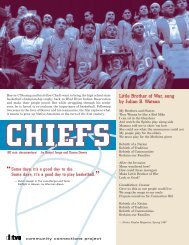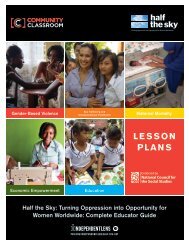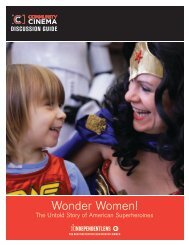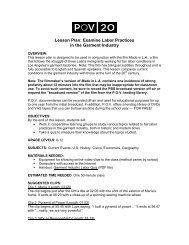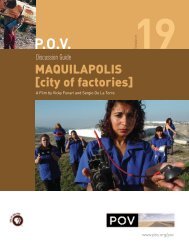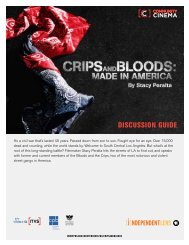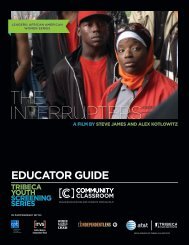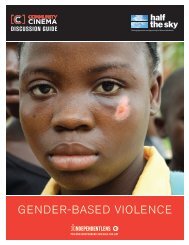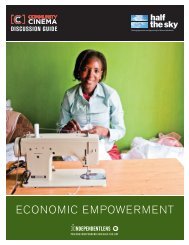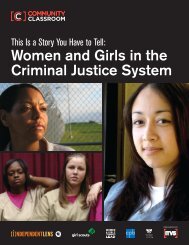educator guide engaging students and teachers through film - ITVS
educator guide engaging students and teachers through film - ITVS
educator guide engaging students and teachers through film - ITVS
- No tags were found...
You also want an ePaper? Increase the reach of your titles
YUMPU automatically turns print PDFs into web optimized ePapers that Google loves.
≠ENGAGING STUDENTS AND TEACHERS THROUGH FILMEducator GuideCan you own a sound? As hip-hop rose from the streets of New York to become a multibillion-dollarindustry, artists such as Public Enemy <strong>and</strong> De La Soul began reusing parts of previously recorded musicfor their songs. But when record company lawyers got involved everything changed. Years before peoplestarted downloading <strong>and</strong> remixing music, hip-hop sampling sparked a debate about copyright, creativity<strong>and</strong> technological change that still rages today.WWW.pbs.org/independentlens/classroom
COMMUNITY classroom: COPYRIGHT CRIMINALStable of contentsHow to Use This Guide & Film 3About the Film 5Activity 1: Hip-Hop <strong>and</strong> the Birth of Sampling* 6Activity 2: Can You Own A Sound? 11Activity 3: Hip-Hop Sampling: Theft or Tribute? 16Activity 4: Sampling in Other Forms of Media <strong>and</strong> Industry 20Guide Credits 25*Recommended national st<strong>and</strong>ards are incorporated at the end of each lessonCOMMUNITY CLASSROOM is an educational resource providing new documentary <strong>film</strong> content <strong>and</strong> accompanyingcurricular materials, lesson plans, <strong>and</strong> homework assignments to high school <strong>and</strong> community college instructors <strong>and</strong>youth-serving community-based organizations. Film content includes approximately 15 to 20 minutes excerptedfrom independently produced documentary <strong>film</strong>s from <strong>ITVS</strong> International’s Global Perspectives Project <strong>and</strong> theEmmy Award-winning PBS series Independent Lens. Content is grouped into subject specific segments thatcorrespond to lesson plans <strong>and</strong> educational activities. All COMMUNITY CLASSROOM materials are designed withkey education st<strong>and</strong>ards in mind, <strong>and</strong> are available, along with the <strong>film</strong> content, on DVD <strong>and</strong> online.COMMUNITY CLASSROOM is a product of the Independent Television Service, with support from the Corporationfor Public Broadcasting, <strong>and</strong> with guidance from PBS Teachers, KQED Education Network, American Associationof Community Colleges, National Council for the Social Studies, National Council of Teachers of English, NationalAssociation for Media Literacy Education <strong>and</strong> National State Teachers of the Year.
COMMUNITY classroom: COPYRIGHT CRIMINALSHOW TO USE THIS GUIDE & FILMEducators can use this <strong>guide</strong> to support viewing of Copyright Criminals while <strong>engaging</strong> <strong>students</strong> in discussions about music sampling, thecreative process, <strong>and</strong> copyright law. To support media literacy, <strong>teachers</strong> can also encourage young men <strong>and</strong> women to reflect on how the musicindustry plays a role in shaping media production practices. The <strong>film</strong> <strong>and</strong> the <strong>educator</strong> <strong>guide</strong> can also inspire conversations about the historicaluse of “borrowed” material in various forms of media, including the visual arts, literature <strong>and</strong> student produced work. Each generation expressesitself in a new musical genre, <strong>and</strong> hip-hop is the voice of today’s youth. With these resources, <strong>students</strong> can better listen, underst<strong>and</strong> <strong>and</strong>respond.GRADE LEVEL9–12, CollegeSUBJECT AREASSocial Studies, Language Arts, Civics, Ethics, Law, Economics,Business, Ethnic Studies, U.S. History, Media Studies, Film <strong>and</strong> MusicProduction, Cultural Studies, Art/Music, Current Events, Government,SociologyACTIVITIESThe activities in this Educator Guide are presented in the followingorder:Activity 1: Hip-Hop <strong>and</strong> the Birth of Sampling This lessonexamines the development of sampling, the roots of hip-hop, <strong>and</strong> howthe practice arose out of the socio-economic conditions of the DJculture in the Bronx in the late 1970s <strong>through</strong> the 1990s.Activity 2: Can You Own A Sound? This lesson introduces theconflict between copyright law <strong>and</strong> the practice of sampling as hiphopgrew into both a cultural <strong>and</strong> economic force, <strong>and</strong> the musicbusiness evoked copyright laws to protect the recordings they own.Activity 3: Hip-Hop Sampling: Theft or Tribute? This lessonintroduces musical legacies that have been created with sampling<strong>and</strong> evaluates whether or not these artists have the recognition theydeserve.Activity 4: Sampling in Other Forms of Media <strong>and</strong> IndustryThis lesson delves deeper into the historical practice of “borrowing”that has occurred across various forms of media, <strong>and</strong> explores howchanges in technology <strong>and</strong> the law have influenced the emergence ofa “remix culture.”The activities target <strong>students</strong> at the high school level, but can bescaffolded to accommodate college settings as well as informalclassrooms such as after-school programs, clubs <strong>and</strong> youth trainingprograms <strong>through</strong> community-based organizations. All content alignswith national st<strong>and</strong>ards for social studies <strong>and</strong> English language arts.Each of the activities is designed to last two traditional class periods(90-120 minutes total); together, the four activities <strong>and</strong> modulesconstitute a unit that can last one to two weeks. All activities aim toincorporate educational content <strong>and</strong> themes that can be integratedinto your existing content curriculum.A Reminder to Teachers <strong>and</strong> EducatorsPlease remember that the activities are <strong>guide</strong>lines only. The contentof this <strong>film</strong> will require heavy preparation <strong>and</strong> scaffolding. We hopethat you will make the necessary adjustments to meet the needs ofyour academic <strong>and</strong> social environment, keeping in mind your own <strong>and</strong>your <strong>students</strong>’ familiarity with the issues, the needs of your school <strong>and</strong>community, your <strong>students</strong>’ grade level <strong>and</strong> social awareness, <strong>and</strong> theclass size <strong>and</strong> duration.<strong>ITVS</strong> COMMUNITY CLASSROOM FILM MODULESWith this Educator Guide, you can build a unit around the entire <strong>film</strong>or you can focus on one or more of the CLASSROOM <strong>film</strong> modules.Each module contains several clips <strong>and</strong> runs approximately five to sixminutes. These short modules can easily be incorporated into yourclassroom curricula. The CLASSROOM <strong>film</strong> modules include thefollowing chapters <strong>and</strong> suggested activity alignments:1. Hip-Hop <strong>and</strong> the Birth of Sampling (5:28) This moduleexplains what sampling is, <strong>and</strong> how it came to be widely used in theearly days of hip-hop music. It also explores the socio-economicconditions that gave rise to hip-hop as a form of cultural expression,<strong>and</strong> introduces the seminal work of the rap group Public Enemy.(Focus: Activity 1, Activity 4)2. Can You Own a Sound? (5:18) This module examines thebasic foundations of copyright law <strong>and</strong> how the music industry beganto respond legally to sampling as hip-hop grew in popularity in the1990s. (Focus: Activity 2, Activity 4)3. Hip-Hop Sampling: Theft or Tribute? (5:45) This moduleintroduces <strong>students</strong> to the musical legacies of Clyde Stubblefield <strong>and</strong>George Clinton, two of the most heavily sampled musicians in hip-hopmusic. (Focus: Activity 3)4. Sampling in Other Forms of Media <strong>and</strong> Industry (4:43) Thismodule explores how other art forms such as the blues <strong>and</strong> WaltDisney movies have “borrowed” from the work of other artists, <strong>and</strong>introduces some of the artists at the front of the “remix” culture thathas emerged in the 21st century. (Focus: Activity 4)Get the Classroom Film Modules:CLASSROOM <strong>film</strong> modules are available on streaming videoformat at www.pbs.org/independentlens/classroom. A free DVDwith the CLASSROOM <strong>film</strong> modules <strong>and</strong> Educator Guide isavailable to classroom <strong>and</strong> community <strong>educator</strong>s by contacting <strong>ITVS</strong>COMMUNITY at classroom@itvs.org. DVD quantities are limited.Independent Television Service (<strong>ITVS</strong>) 651 brannan Street, suite 410 San Francisco, CA 94107 Phone: 415.356.8383 email: itvs@itvs.org web: www.pbs.org/independentlens/classroom page 3
COMMUNITY classroom: COPYRIGHT CRIMINALSGet the Full Film on DVDIn the event that you do not have the CLASSROOM Film Modules,the activities can still be applied to the <strong>film</strong> in its entirety. As theteacher or <strong>educator</strong>, make the necessary adjustments to fit theneeds of your learning community. DVD copies of CopyrightCriminals can be purchased from: http://www.indiepix<strong>film</strong>s.com/<strong>film</strong>/4074?ref=copyright-criminalsA Reminder to Teachers <strong>and</strong> EducatorsThe full <strong>film</strong> contains some adult language.RESOURCES<strong>ITVS</strong> COMMUNITY CLASSROOM MATERIALS• Educator Guide• Teacher H<strong>and</strong>outs <strong>and</strong> Assessment Tools• Community <strong>and</strong> Viewer Discussion GuideAll resources are available at:www.pbs.org/independentlens/classroomWEBSITES• PBS Companion Website http://www.pbs.org/independentlens/copyright-criminals/• Best practices in Fair Use, The Center for Social Media:http://www.centerforsocialmedia.org/resources/fair_use/• Core Principles in Media Literacy Education, from the NationalAssociation for Media Literacy Education (NAMLE):http://www.namle.net/core-principles• Media Literacy MAP Frameworks, KQED Education Network:http://www.kqed.org/topics/education/medialiteracy/ mapframework.jsp• A list of additional online resources about the history of hip-hop <strong>and</strong>copyright law:http://www.pbs.org/independentlens/copyright-criminals/more.htmlA Reminder to Teachers <strong>and</strong> EducatorsAs always, be sure to check these URLs to see if they are still live,if the content is appropriate for your <strong>students</strong> <strong>and</strong> classroom, <strong>and</strong> ifthey can be accessed at your school. In the event that your school orworkplace blocks any of these URLs, access the Web at home <strong>and</strong>make the necessary print copies for your classroom.BOOKS• Banjoko, Adisa, Lyrical Swords: Hip-hop <strong>and</strong> Politics in the Mix,YinSumi Press (2004).• Chang, Jeff, Can’t Stop Won’t Stop: A History of the Hip-hopGeneration, St. Martin’s Press (2005).• Chang, Jeff, Total Chaos: The Art <strong>and</strong> Aesthetics of Hip-hop,Basic Civitas Books (2007).• Cross, Brian, It’s Not About a Salary: Rap, Race <strong>and</strong> Resistancein Los Angeles, Verso Books (1993).• Kitwana, Bakari, The Hip-hop Generation: Young Blacks <strong>and</strong> theCrisis in African American Culture, Basic Civitas Books (2003).• Spady, James G., H. Samy Alim <strong>and</strong> Samir Meghelli, Tha GlobalCipha: Hip-hop Culture <strong>and</strong> Consciousness, Black HistoryMuseum Press (2006).• McLeod, Kembrew, Freedom of Expression: Resistance <strong>and</strong>Repression in the Age of Intellectual Property, University ofMinnesota Press (2007).Independent Television Service (<strong>ITVS</strong>) 651 brannan Street, suite 410 San Francisco, CA 94107 Phone: 415.356.8383 email: itvs@itvs.org web: www.pbs.org/independentlens/classroom page 4
COMMUNITY classroom: COPYRIGHT CRIMINALSABOUT THE FILMIs it acceptable to take the work of others <strong>and</strong> make that part ofyour own creation? Can you copyright a sound? Copyright Criminalsexamines these questions <strong>and</strong> others raised by hip-hop artists’ useof sampled music. Through interviews with producers <strong>and</strong> DJs,musicologists <strong>and</strong> legal experts, the <strong>film</strong> lays out the issues involvedin sampling <strong>and</strong> describes how lawsuits have changed the way hiphopmusic is produced.Hip-hop began as street entertainment <strong>and</strong> musical expressionamong African Americans <strong>and</strong> Latinos in poverty-stricken areas of theBronx in the 1970s. It became not just a genre of music but a culturalmovement, encompassing dancing, graffiti art <strong>and</strong> slang. At streetparties, hip-hop DJs found ways to emphasize <strong>and</strong> extend the drumbreaks in popular music, <strong>and</strong> then began incorporating those breaksin their own musical creations. One example is Clyde Stubblefield’s“Funky Drummer,” recorded with James Brown, which has been themost sampled of those breaks. Throughout the <strong>film</strong>, numerous clips ofhip-hop music illustrate the use of sampling.Sampling became the hallmark of hip-hop music, with somerecordings using dozens of samples. As long as hip-hop wasperceived as an urban underground phenomenon, sampling wentunchallenged. But, as the popularity of the music grew during the1980s <strong>and</strong> early 1990s <strong>and</strong> hip-hop began making money, others inthe music industry took notice. Traditional artists, whose music wasbeing sampled, felt they should be paid for the use of their music <strong>and</strong>their record labels filed lawsuits for infringement of copyright.Two cases in particular, both brought in the early 1990s, had soberingeffects on the practice of sampling: the Biz Markie case, in whichsinger-songwriter Gilbert O’Sullivan sued for the use of a phrase fromhis popular song, “Alone Again, Naturally,” <strong>and</strong> the $1.7 million lawsuitagainst De La Soul for unauthorized sampling of the Turtles’ music.Legal actions against hip-hop producers have made them morecautious <strong>and</strong> has given rise to a new industry of sample licensing,since permissions must be obtained for every piece of sampled musicon a new recording. Some musicians have found ways to skirt the lawby altering their samples electronically, <strong>and</strong> some samplers are goingunderground.Legal victories have settled the claims of some record labels, whileothers have ended in defeat; however, questions about samplingremain. Is it art? Is it improvisation on an existing theme or outrighttheft of artistry? Does it really use technology in an original <strong>and</strong>creative way?Sampling lawsuits have also brought to light the need for copyrightlaw to adjust to new technologies for recording <strong>and</strong> distribution ofcreative works. What the <strong>film</strong> makes clear is that the developmentof new digital recording technology has democratized the processof creating music. Anyone can produce a mashup <strong>and</strong> send it out onthe Internet. Popular music today is part of a vibrant remix culturethat threatens the traditional structure of the music business. Asrecord producer Tom Silverman says at the end of the <strong>film</strong>, “Societymoves forward…. It evolves <strong>through</strong> taking old things <strong>and</strong> changingthem.” Musicians <strong>and</strong> recording artists, using digital technologies, arefollowing their own rule book. Clearly, copyright law needs to catchup in order to protect artists’ rights while allowing musical creativity togrow <strong>and</strong> flourish.Independent Television Service (<strong>ITVS</strong>) 651 brannan Street, suite 410 San Francisco, CA 94107 Phone: 415.356.8383 email: itvs@itvs.org web: www.pbs.org/independentlens/classroom page 5
COMMUNITY classroom: COPYRIGHT CRIMINALSActivity 1Hip Hop <strong>and</strong> the Birth of Sampling(90-120 min + assignments)“There was always a culture of borrow <strong>and</strong> take,because there was a culture [that was] foundedupon a lack of resources.”-Bobbito Garcia (Rocksteady Crew)Independent Television Service (<strong>ITVS</strong>) 651 brannan Street, suite 410 San Francisco, CA 94107 Phone: 415.356.8383 email: itvs@itvs.org web: www.pbs.org/independentlens/classroom page 6
COMMUNITY classroom: COPYRIGHT CRIMINALSActivity 1Hip Hop <strong>and</strong> the Birth of Sampling(90-120 min + assignments)Subject areas: Social Studies, Sociology, Economics, History, Cultural Studies, Media StudiesLesson Purpose:The development of sampling, it could be argued, is a classic “making something out of nothing” scenario. Hip-hopwas birthed in the innovation of manipulating music on vinyl records with turntables; making music with samplers isa logical next step. This lesson examines the roots of hip-hop <strong>and</strong> how sampling arose out of necessity — becauseof the conditions <strong>and</strong> the creativity of the practitioners.Objectives:Students will:• Underst<strong>and</strong> the roots <strong>and</strong> the socioeconomic context of hip-hop culture.• Examine the use of sampling in hip-hop: its origins as well as its use over time.• Compare <strong>and</strong> contrast heavily sampled seminal hip-hop music <strong>and</strong> artists with more contemporary forms.Skills: Stating <strong>and</strong> supporting opinions in class discussions <strong>and</strong> in writing; analytical reading <strong>and</strong> viewing; notetaking; interpreting information <strong>and</strong> drawing conclusions; critical thinking; identifying cause <strong>and</strong> effect; identifyingrelationships <strong>and</strong> patterns; creating various forms of media; oral presentationMaterials:• Computers with an Internet access <strong>and</strong>/or with DVD capability• LCD projector or DVD player• COPYRIGHT CRIMINALS Discussion Guide• COPYRIGHT CRIMINALS Film Module 1 “Hip Hop <strong>and</strong> the Birth of Sampling”• Whiteboard/markers, or chalkboard/chalk• Teacher H<strong>and</strong>out A: Assignment Rubric• Student H<strong>and</strong>out A: Module 1 Note Taking Guide• Student H<strong>and</strong>out B: QuotesProcedures:PREVIEWING ACTIVITY:1. Introduction:Have <strong>students</strong> copy this quote from the <strong>film</strong> <strong>and</strong> then write quick responses to it:The idea of not having any instruments, but having a turntable <strong>and</strong> saying, well, fine, this is my instrument. Youknow? And you see it now with people with overturned buckets <strong>and</strong> pots <strong>and</strong> pans. And we saw it then.–Saul Williams• I think hip-hop started because…• Other objects/tools that could be used as musical instruments are…• An example of when people used or borrowed something to create something new is…Call on <strong>students</strong> to share their responses <strong>and</strong> discuss opinions.Independent Television Service (<strong>ITVS</strong>) 651 brannan Street, suite 410 San Francisco, CA 94107 Phone: 415.356.8383 email: itvs@itvs.org web: www.pbs.org/independentlens/classroom page 7
COMMUNITY classroom: COPYRIGHT CRIMINALS2. Sampling Glossary: Post <strong>and</strong> review the terms from the Independent Lens website (http://www.pbs.org/independentlens/copyright-criminals/glossary.html). Have <strong>students</strong> share what they know <strong>and</strong> what they’ve heardabout sampling, hardware, software, music-making, <strong>and</strong> hip-hop. Construct a grade-level-appropriate workingclassroom definition of what “sample” is. (For example, a piece of an existing document or recording that is thenused in a new work of art.) The <strong>film</strong> module for this lesson opens with a definition of “sample,” so you can comparethis with the class’s definition.3. The Birth of Hip-Hop: Have <strong>students</strong> read the “Making a Name” excerpted from Jeff Chang’s Can’t StopWon’t Stop: A History of the Hip-Hop Generation (http://cantstopwontstop.com/reader/excerpt/).For visual <strong>and</strong> audio context, it would be useful to show the “Masculinity” video module from the Independent Lens<strong>film</strong> Hip-Hop: Beyond Beats <strong>and</strong> Rhymes. The last portion of this module focuses on the social <strong>and</strong> economicconditions of the Bronx during the early days of hip-hop. You can find it at http://www.pbs.org/independentlens/classroom/hiphop.html.It may also be useful to show the1983 Sundance Gr<strong>and</strong> Prize documentary <strong>film</strong> Style Wars (http://www.stylewars.com), which has some great footage of New York City during that era, as well as hip-hop MCs,DJs, <strong>and</strong> breakdancers. In addition, search <strong>and</strong> play video clips online such as: New York City – The SouthBronx in the 1970s <strong>and</strong> 1980s (http://www.youtube.com/watch?v=AtI-En92Xso) <strong>and</strong> (http://www.youtube.com/watch?v=kqawnkoCi1Y), <strong>and</strong> 1970s Gangs <strong>and</strong> Graffiti (http://www.youtube.com/watch?v=Nz8tOK8_NGg&NR=1). As extended background reading <strong>and</strong> context, it would be informative for the teacher <strong>and</strong> <strong>students</strong>to read more of Jeff Chang’s book, especially the first two chapters “Babylon is Burning: 1968-1977” (the chapterthe previous excerpt is from) <strong>and</strong> “Planet Rock: 1975-1986.”• What were Kool Herc’s influences?• How did Kool Herc make do with what he had <strong>and</strong> innovate to create something better?• How could a rec-room party have such an influence on people <strong>and</strong> the birth of a culture?• What do you notice about the physical environment of New York City in the 1970s <strong>and</strong> 1980s? What doyou notice about the cultural environment?• Why do you think the cultural phenomenon of hip-hop started specifically in New York City during this time?4. Timeline of Hip-Hop: Have <strong>students</strong> read the “About Hip-Hop Timeline” from the Independent Lens website(http://www.pbs.org/independentlens/hiphop/timeline.htm) in pairs. Assign a different decade to each pair. Directpairs to note dates, events, <strong>and</strong> people that st<strong>and</strong> out to them <strong>and</strong> explain why. They can also add any events<strong>and</strong> people they feel had an impact on hip-hop during the decade, but that aren’t on the timeline. Then, have the<strong>students</strong> get into a larger group (perhaps four total) to compare notes with other pairs who are studying the samedecade. Have each of the four larger groups report back to the class. You can also refer to the “About Hip-Hop”glossary on the Independent Lens website to clarify any terms (http://www.pbs.org/independentlens/hiphop/glossary.htm). Ask the <strong>students</strong> the following questions:• What were the key events/people that drove that decade in hip-hop?• How commercially viable was hip-hop in that decade? How can hip-hop be positioned in relation to (orwithin) mainstream culture in that decade?• What were the primary changes <strong>and</strong> innovations in hip-hop during that period?• In what ways has hip-hop has changed since that period (sound/visual style/fashion/etc.)? Why?• What do you predict the this new decade, the second decade of the 21st century, will hold for hip-hop? Doyou agree or disagree that, as rapper Nas titled his 2006 album, Hip-Hop is Dead?5. Provide Background Information on COPYRIGHT CRIMINALS: Briefly introduce the <strong>film</strong> CopyrightCriminals. Note that the <strong>film</strong> module will cover the roots of hip-hop as well as the “golden age” of sampling. Have<strong>students</strong> read COPYRIGHT CRIMINALS Discussion Guide pages 2-3, which are particularly about the roots ofhip-hop.Independent Television Service (<strong>ITVS</strong>) 651 brannan Street, suite 410 San Francisco, CA 94107 Phone: 415.356.8383 email: itvs@itvs.org web: www.pbs.org/independentlens/classroom page 8
COMMUNITY classroom: COPYRIGHT CRIMINALSVIEWING THE FILM:6. Viewing the Film Module: Instruct <strong>students</strong> to take notes on Student H<strong>and</strong>out A: Module 1 Note TakingGuide as they view the COPYRIGHT CRIMINALS Film Module, <strong>and</strong> have them record the perspectives ofvarious subjects from the <strong>film</strong>.REFLECTING ON THE FILM:7. Review <strong>and</strong> Discuss: Debrief the module <strong>and</strong> notes by discussing them together as a class. Have <strong>students</strong>review the Student H<strong>and</strong>out B: Quotes before the discussion. Use the following <strong>guide</strong> questions:• What were the original reasons for using turntables <strong>and</strong> samplers to make music?• Do you think the turntable itself is a musical instrument? Why or why not?• How did the music-making process of groups such as Public Enemy use samples? What was their purpose<strong>and</strong> how did they view their use of sampling to create music? Do you agree or disagree?• How was Public Enemy revolutionary both in their sound <strong>and</strong> in their message? What does it mean that theywere “reanimating” the voices of iconic black leaders by sampling their speeches?• Can you think of any recent hip-hop songs that use samples? How do you think the artists were able to usethose samples in the current context of hip-hop as a worldwide economically viable industry?8. A Deeper Look at the History of Sampling: Have <strong>students</strong> read/listen to “Steinski Gives A SamplingHistory Lesson” an interview with sampling pioneer Steinski <strong>and</strong> retrospective of 30 decades of sampling fromNational Public Radio (http://www.npr.org/templates/story/story.php?storyId=93844583). Have <strong>students</strong> listento “Steinski’s Sampler of Sampling” for some examples of other sampled music as well his own “Lesson” mixes.(Note: Teachers can also use websites such as Grooveshark (http://listen.grooveshark.com/), Last FM (http://www.last.fm), P<strong>and</strong>ora Radio (http://www.p<strong>and</strong>ora.com), Myspace Music (http://music.myspace.com), <strong>and</strong> YouTube(http://www.youtube.com) to search for <strong>and</strong> stream music online for classroom use, especially if you want <strong>students</strong>to listen to full versions of songs from the <strong>film</strong>).• What is Steinski’s view on sampling? What was his intention with creating the “collage” pieces?• How did the featured artists use sampling in their music?• Sampling started as a necessity because, to quote Bobbito Garcia from the <strong>film</strong>, “There was always aculture of borrow <strong>and</strong> take, because there was a culture [that was] founded upon a lack of resources.” Isthat the case now?9. Assignment - Compare <strong>and</strong> Contrast Research Project: In small groups, have <strong>students</strong> research twohip-hop artists: one from the “golden era” of sampling (De La Soul, Public Enemy, Beastie Boys, Boogie DownProductions, etc.) <strong>and</strong> one more contemporary hip-hop artist of their choice. Have them compile information <strong>and</strong>write their analysis <strong>and</strong> include songs, videos, etc. They should look specifically at the social context that informedthe music of the “golden era,” versus that of the contemporary artist <strong>and</strong> the current times: social, political, <strong>and</strong>economic conditions <strong>and</strong> events (e.g. recession, first African American president). They should also analyzedifferences in the culture <strong>and</strong> music industry that they occupy: how much ownership they have of their music,where the money for producing their music comes from, how the artists or their label promote the music, etc. Theycan also look at the differences in the production techniques, sound, imagery, lyrics, <strong>and</strong> so on. Have them collectimages, video, audio, interviews, news articles, written accounts, etc., <strong>and</strong> organize them into time periods, drawingconnections between the personal <strong>and</strong> the historical, <strong>and</strong> showing developments over time. They should thenpublish their findings on a web page, blog, podcast, PowerPoint, or other form of audio/visual <strong>and</strong>/or web-basedpresentation. A web-based timeline tool such as Capzles (http://www.capzles.com) is a good place to createthese.AssessmentUse Teacher H<strong>and</strong>out A: Assignment Rubric to assess groups’ research projects. Students should receive therubric in advance to <strong>guide</strong> their research.Independent Television Service (<strong>ITVS</strong>) 651 brannan Street, suite 410 San Francisco, CA 94107 Phone: 415.356.8383 email: itvs@itvs.org web: www.pbs.org/independentlens/classroom page 9
COMMUNITY classroom: COPYRIGHT CRIMINALSExtension activities for <strong>students</strong>:1. Using the process the Bomb Squad worked with, create a “sample script,” such as the one used by PublicEnemy in the <strong>film</strong>. Form a group, <strong>and</strong> have each member brainstorm sounds <strong>and</strong> samples they might bring in tomake into an audio collage. Map out the track on graph or chart paper.2. Research a favorite song or music piece. Try to identify the tracks that have been sampled to create the piece.Websites such as Who Sampled? (http://whosampled.com) <strong>and</strong> The-Breaks (http://the-breaks.com) can be goodresources.3. Give small groups an assortment of everyday items found in the classroom <strong>and</strong> the household: scissors, rulers,jars, etc. <strong>and</strong> have them create music with them. Have them brainstorm other items they could use. You canreference <strong>and</strong> show examples, such as the Broadway stage show STOMP.Recommended National St<strong>and</strong>ardsTHE CONSORTIUM OF NATIONAL ARTS EDUCATION ASSOCIATIONSMusic: Grades 9-12St<strong>and</strong>ard 6: Listening to, analyzing, <strong>and</strong> describing musicSt<strong>and</strong>ard 9: Underst<strong>and</strong>ing music in relation to history <strong>and</strong> cultureNATIONAL COUNCIL OF TEACHERS OF ENGLISHGrades K-12St<strong>and</strong>ard 1: Students read a wide range of print <strong>and</strong> non-print texts to build an underst<strong>and</strong>ing of texts, ofthemselves, <strong>and</strong> of the cultures of the United States <strong>and</strong> the world; to acquire new information; to respondto the needs <strong>and</strong> dem<strong>and</strong>s of society <strong>and</strong> the workplace; <strong>and</strong> for personal fulfillment. Among these texts arefiction <strong>and</strong> nonfiction, classic <strong>and</strong> contemporary works.St<strong>and</strong>ard 7: Students conduct research on issues <strong>and</strong> interests by generating ideas <strong>and</strong> questions, <strong>and</strong> by posingproblems. They gather, evaluate, <strong>and</strong> synthesize data from a variety of sources (e.g., print <strong>and</strong> non-print texts,artifacts, people) to communicate their discoveries in ways that suit their purpose <strong>and</strong> audience.St<strong>and</strong>ard 8: Students use a variety of technological <strong>and</strong> information resources (e.g., libraries, databases, computernetworks, video) to gather <strong>and</strong> synthesize information <strong>and</strong> to create <strong>and</strong> communicate knowledge.NATIONAL COUNCIL FOR THE SOCIAL STUDIESI. CultureI.a. Analyze <strong>and</strong> explain the ways groups, societies, <strong>and</strong> cultures address human needs <strong>and</strong> concerns;INTERNATIONAL SOCIETY FOR TECHNOLOGY IN EDUCATIONSt<strong>and</strong>ard 1. Creativity <strong>and</strong> innovation• Students demonstrate creative thinking, construct knowledge, <strong>and</strong> develop innovative products <strong>and</strong>processes using technology.St<strong>and</strong>ard 3. Research <strong>and</strong> information fluency• Students apply digital tools to gather, evaluate, <strong>and</strong> use information.Independent Television Service (<strong>ITVS</strong>) 651 brannan Street, suite 410 San Francisco, CA 94107 Phone: 415.356.8383 email: itvs@itvs.org web: www.pbs.org/independentlens/classroom page 10
COMMUNITY classroom: COPYRIGHT CRIMINALSActivity 2Can You Own a Sound?(90-120 min + assignments)“If you sample one note of a sound recording, it’scopyright infringement… At the end of the day, thecourt said, not only is this copyright infringement,but we see criminal prosecution in mind for thisone.-Anthony Berman (Entertainment Lawyer)Independent Television Service (<strong>ITVS</strong>) 651 brannan Street, suite 410 San Francisco, CA 94107 Phone: 415.356.8383 email: itvs@itvs.org web: www.pbs.org/independentlens/classroom pagE 11
COMMUNITY classroom: COPYRIGHT CRIMINALSActivity 2Can You Own a Sound?(90-120 min + assignments)Subject areas: Social Studies, Civics, Government, Sociology, Language Arts, Economics, Ethics, Law, Business,Media StudiesLesson Purpose:Copyright law developed over time to protect intellectual property of artists <strong>and</strong> creators. As sampling in hip-hopgrew into both a cultural <strong>and</strong> economic force, the music business evoked copyright laws to protect the recordingsthey own. This lesson looks at the ways that artists borrow <strong>and</strong> appropriate in the creative process acrossmediums. Students will take a look at the issue from both sides <strong>and</strong> debate whether or not “copying” should beallowed.Objectives:Students will:• Learn about copyright law <strong>and</strong> the exception of fair use.• Investigate artistic appropriation in visual art, <strong>film</strong>, <strong>and</strong> literature, as well as in music.• Prepare <strong>and</strong> present a debate with their classmates.Skills: Stating <strong>and</strong> supporting opinions in class discussions <strong>and</strong> in writing; analytical reading <strong>and</strong> viewing; notetaking; interpreting information <strong>and</strong> drawing conclusions; critical thinking; identifying cause <strong>and</strong> effect; identifyingrelationships <strong>and</strong> patterns; creating various forms of mediaMaterials:• Computers with Internet. LCD projector or DVD player• COPYRIGHT CRIMINALS Discussion Guide• COPYRIGHT CRIMINALS Film Module 2 “Can You Own a Sound?”• Whiteboard/markers, or chalkboard/chalk• Student H<strong>and</strong>out A: Module 2 Note Taking Guide• Student H<strong>and</strong>out B: Quotes• Student H<strong>and</strong>out C: Debate Roles & Format• Student H<strong>and</strong>out D: Debate Notes• Student H<strong>and</strong>out E: Debate Peer Evaluation RubricNote to Teachers: For your own background information <strong>and</strong> preparation, there are good reference primers forcopyright law <strong>and</strong> fair use on the Teaching Copyright website (http://teachingcopyright.org) <strong>and</strong> in the article“Copyright for Educators” on the KOCE (PBS) website (http://www.koce.org/classroom/copyright.htm). You maywant to give additional “intro” lessons using these materials if your class needs more background <strong>and</strong> context.Procedures:PREVIEWING ACTIVITY:1. Introducing Copyright Law & Music:Ask the class if it is anyone’s birthday. If not, ask who will be having a birthday soon. Invite the class to sing“Happy Birthday to You.” After singing, read the articles “How Long Do Copyrights Last?” <strong>and</strong> “The CopyrightIndependent Television Service (<strong>ITVS</strong>) 651 brannan Street, suite 410 San Francisco, CA 94107 Phone: 415.356.8383 email: itvs@itvs.org web: www.pbs.org/independentlens/classroom page 12
COMMUNITY classroom: COPYRIGHT CRIMINALSTerm Extension Act of 1998” from the Sampling Law website (http://superswell.com/samplelaw/main.html) to theclass. Have <strong>students</strong> respond to the following:• I was/was not surprised to hear that “Happy Birthday to You” is copyrighted because…• The composers of the song should/should not receive royalties because…• Anyone should/should not be able to sing <strong>and</strong> use this song for free because…2. Borrowing vs. Stealing:Have <strong>students</strong> read “Something Borrowed” by Malcolm Gladwell from The New Yorker website (http://www.newyorker.com/archive/2004/11/22/041122fa_fact). (Note: “The ecstasy of influence: A plagiarism” by JonathanLethem (http://www.harpers.org/archive/2007/02/0081387) can be used as an additional reading with similararguments using different examples).Discuss the following with the class:• Gladwell gives many examples of artistic appropriation, from literature to journalism to music. Do you agreethat many artists borrow as a fundamental part of the artistic/creative process? Should artists have thefreedom to do so?• Gladwell makes a distinction between borrowing that is derivative versus borrowing that is transformative. Isone wrong <strong>and</strong> the other right? How can we tell the difference <strong>and</strong> who ultimately determines that?• What other examples of artistic appropriation can you think of?3. The Fair Use Exception:Instruct <strong>students</strong> to read about fair use as related to borrowing from copyrighted works on the Sampling Lawwebsite (http://www.superswell.com/samplelaw/fairuse.html). Discuss <strong>and</strong> clarify what fair use means <strong>and</strong> what isdeemed fair use. Introduce the case of the Associated Press vs. Shepard Fairey, the artist who created the iconicObama “Hope” poster which became ubiquitous during the 2008 Presidential campaign. The AP filed a lawsuitagainst Fairey claiming copyright infringement because he used an AP-owned photograph as a reference. Have<strong>students</strong> read <strong>and</strong> refer to this op-ed piece from The Huffington Post (http://www.huffingtonpost.com/jonathanmelber/the-ap-hase-no-case-again_b_165068.html),which includes references <strong>and</strong> visual examples from othercases such as Blanch vs. Koons. Fairey also speaks about the case on his own website (http://obeygiant.com/headlines/the-ap-obama-referencing#reference1). Take a quick thumbs-up/thumbs-down poll to find out if the classthinks that Fairey did indeed infringe upon the AP’s rights to the image he used.Discuss the following with the <strong>students</strong>:• If you would find Fairey guilty of copyright infringement, explain why.• If you would judge Fairey’s poster as falling under the fair use exception, explain why.• Should Fairey have given credit to the photograph he referenced when he first distributed his poster? Whyor why not?• Should the AP pursue the lawsuit even if the photographer himself does not see Fairey’s use as illegal?Explain.• Should the AP <strong>and</strong>/or the photographer be compensated for the use of the photograph as a reference?Why or why not?• Is there any difference between a visual artist using a photograph for reference <strong>and</strong> a musical artist using asample of a sound recording?4. Provide Background Information on COPYRIGHT CRIMINALS:Briefly introduce the <strong>film</strong> Copyright Criminals. Note how the <strong>film</strong> module will cover how artists have referenced <strong>and</strong>appropriate other works in music, visual art, <strong>and</strong> <strong>film</strong>. Have <strong>students</strong> read <strong>and</strong> discuss COPYRIGHT CRIMINALSDiscussion Guide page 2, which features the <strong>film</strong>makers talking about how they encountered <strong>and</strong> dealt withcopyright issues in creating the <strong>film</strong> itself. There is a related interview with the <strong>film</strong>makers on the Independent Lenswebsite (http://www.pbs.org/independentlens/copyright-criminals/makingof.html). Have them also read “CopyrightOverview” <strong>and</strong> “What is Fair Use?” on page 4 of the Discussion Guide.Independent Television Service (<strong>ITVS</strong>) 651 brannan Street, suite 410 San Francisco, CA 94107 Phone: 415.356.8383 email: itvs@itvs.org web: www.pbs.org/independentlens/classroom page 13
COMMUNITY classroom: COPYRIGHT CRIMINALSVIEWING THE FILM:5. Viewing the Film Module: Instruct <strong>students</strong> to take notes on Student H<strong>and</strong>out A: Module 2 Note TakingGuide as they view the COPYRIGHT CRIMINALS Film Module, recording the views of the different speakersin the module. After watching, give <strong>students</strong> time to note whether the speaker is for or against sampling <strong>and</strong> otherforms of artistic appropriation.REFLECTING ON THE FILM:6. Review <strong>and</strong> Discuss: Debrief the module <strong>and</strong> notes by discussing them together as a class. Have <strong>students</strong>review the Student H<strong>and</strong>out B: Quotes before the discussion. Use the following <strong>guide</strong> questions:• Should sampling someone else’s music — even one note — without permission be an offense suitable forcriminal prosecution? Why or why not?• Who do you agree with the most in the <strong>film</strong> module? Who do you most disagree with? Explain.• How did the early cases of sample lawsuits in the 1990s change the way hip-hop producers approachedsampling in subsequent decades?• How is race involved in the sample clearance/copyright industry?• What is a fair rate to charge for sampling someone’s music with permission?• Should sampling be treated differently from covering a song in terms of copyright law <strong>and</strong> clearance? Whyor why not? If so, how?• What, if any, are the exceptions for when “copying” is acceptable?7. Debate Preparation: Review copyright law <strong>and</strong> fair use with the class <strong>and</strong> explain that the <strong>students</strong> will debatewhether artists should have the ability to “borrow” freely in the process of creation. Organize <strong>students</strong> into groupsof four to six, with groups being either “PRO” artistic <strong>and</strong> creative freedom or “CON.” The “PRO” side can alsorefer to the Independent Lens interview with legal scholar Larry Lessig (http://www.pbs.org/independentlens/copyright-criminals/fair-use.html), <strong>and</strong> both sides can benefit from the Independent Lens “Learn More” page(http://www.pbs.org/independentlens/copyright-criminals/more.html#copy). Distribute <strong>and</strong> review StudentH<strong>and</strong>out C: Debate Roles & Format <strong>and</strong> have groups decide each member’s role(s). Then, direct groups toprepare their arguments <strong>and</strong> statements using Student H<strong>and</strong>out D: Debate Notes. They should research <strong>and</strong>prepare examples to support their side: from the <strong>film</strong> or readings, or from further research.8. Assignment - Debate: Arrange the classroom into a debate-audience format with two sides facing eachother in front of the rest of the class. Review the expectations with the criteria outlined on Student H<strong>and</strong>out E:Debate Peer Evaluation Rubric. Moderate the debate by following the debate format. Debrief by discussing thepersuasiveness of the arguments <strong>and</strong> whether or not there can be a compromise or a way for the system to allow<strong>and</strong> encourage creativity, while at the same time protecting the rights of the creators.AssessmentDirect <strong>students</strong> in the audience to assess their classmates in the debate groups using Student H<strong>and</strong>out E:Debate Peer Evaluation Rubric. You can also use the same rubric to do a teacher evaluation of the debategroups.Extension activities for <strong>students</strong>:1. Host a round-table discussion with individuals who are local resources on the subject of copyright: artists,musicians, lawyers, musicologists. Prepare questions <strong>and</strong> record responses from these “experts.”2. Using visual art, music, literature, or other areas of artistic expression, create a piece that draws from <strong>and</strong>appropriates an existing work. Have the artist explain their intentions, how it differs from the referenced work, how<strong>and</strong> why they used the previous work, <strong>and</strong> how their experience was in creating the work.Independent Television Service (<strong>ITVS</strong>) 651 brannan Street, suite 410 San Francisco, CA 94107 Phone: 415.356.8383 email: itvs@itvs.org web: www.pbs.org/independentlens/classroom page 14
COMMUNITY classroom: COPYRIGHT CRIMINALS3. Research the current state of copyright law. What groups or organizations want stronger copyright <strong>and</strong>intellectual property laws <strong>and</strong> why? How are they going about their cause? On the other side, what groups ororganizations want greater artistic freedom within the law? How are they fighting to get it?4. Research <strong>and</strong> prepare a presentation of artists who have referenced or appropriated other art in their works.Have the class evaluate whether or not the works are transformative or derivative. The class could develop criteriato make such a determination.5. Research the creativity, legality <strong>and</strong> value of the DJ “mixtape.” Good starter articles include this piece on theRIAA raid of the Atlanta studio of DJ Drama in 2007 (http://www.reuters.com/article/idUSN2135284520070123),<strong>and</strong> this piece on “artist mixtapes” as a means to break into the industry (http://www.reuters.com/article/idUSTRE60T0K820100130). A good resource for a wide range of DJ mixes is Mixcrate (http://mixcrate.com).Recommended National St<strong>and</strong>ardsMID-CONTINENT RESEARCH FOR EDUCATION AND LEARNING STANDARDSCareer EducationBusiness EducationSt<strong>and</strong>ard 6. Underst<strong>and</strong>s how the legal system affects businessSt<strong>and</strong>ard 34. Underst<strong>and</strong>s the role of ethics in the business worldCivicsSt<strong>and</strong>ard 3. Underst<strong>and</strong>s the sources, purposes, <strong>and</strong> functions of law, <strong>and</strong> the importance of the rule of lawfor the protection of individual rights <strong>and</strong> the common goodNATIONAL COUNCIL FOR THE SOCIAL STUDIESV. Individuals, groups, & institutionsV.a. Apply concepts such as role, status, <strong>and</strong> social class in describing the connections <strong>and</strong> interactions ofindividuals, groups, <strong>and</strong> institutions in society;VII. Production, distribution, & consumptionVII.b. Analyze the role that supply <strong>and</strong> dem<strong>and</strong>, prices, incentives, <strong>and</strong> profits play in determining what isproduced <strong>and</strong> distributed in a competitive market system;VIII. Science, technology, & societyVIII.a. Identify <strong>and</strong> describe both current <strong>and</strong> historical examples of the interaction <strong>and</strong> interdependence ofscience, technology, <strong>and</strong> society in a variety of cultural settings;X. Civic ideals & practicesX.d. Practice forms of civic discussion <strong>and</strong> participation consistent with the ideals of citizens in ademocratic republic;INTERNATIONAL SOCIETY FOR TECHNOLOGY IN EDUCATIONSt<strong>and</strong>ard 5: Digital citizenship• Students underst<strong>and</strong> human, cultural, <strong>and</strong> societal issues related to technology <strong>and</strong> practice legal <strong>and</strong>ethical behaviorIndependent Television Service (<strong>ITVS</strong>) 651 brannan Street, suite 410 San Francisco, CA 94107 Phone: 415.356.8383 email: itvs@itvs.org web: www.pbs.org/independentlens/classroom page 15
COMMUNITY classroom: COPYRIGHT CRIMINALSActivity 3Hip Hop Sampling: Theft or Tribute?(90-120 min + assignments)“I never got a thanks. I never got ahello, how are you doing, or anythingfrom any of the rap artists or anything.-Clyde Stubblefield (James Brown’s drummer)Independent Television Service (<strong>ITVS</strong>) 651 brannan Street, suite 410 San Francisco, CA 94107 Phone: 415.356.8383 email: itvs@itvs.org web: www.pbs.org/independentlens/classroom page 16
COMMUNITY classroom: COPYRIGHT CRIMINALSActivity 3Hip Hop Sampling: Theft or Tribute?(90-120 min + assignments)Subject areas: Social Studies, Civics, Government, Sociology, Language Arts, Economics, Ethics, Art/Music,Business, Media StudiesLesson Purpose:The course of sampled music has created a cycle in which sampled artists can gain an audience in a newgeneration of listeners. This lesson takes into account the attention that artists can <strong>and</strong> have received by beingsampled. Students will look into musical legacies that have been created with sampling <strong>and</strong> create their ownversions of oft-sampled records.Objectives:Students will:• Identify samples in popular songs.• Investigate the far-reaching effects of certain artists <strong>and</strong> records that have been sampled again <strong>and</strong> again.• Reflect on how some artists’ careers have been revived from being sampled.• Create their own musical composition using a sampled break.Skills: Stating <strong>and</strong> supporting opinions in class discussions <strong>and</strong> in writing; analytical reading <strong>and</strong> viewing; notetaking; interpreting information <strong>and</strong> drawing conclusions; critical thinking; identifying cause <strong>and</strong> effect; identifyingrelationships <strong>and</strong> patterns; creating various forms of mediaMaterials:• Computers with Internet LCD projector or DVD player• COPYRIGHT CRIMINALS Discussion Guide• COPYRIGHT CRIMINALS Film Module 3 “Hip Hop Sampling: Theft or Tribute?”• whiteboard/markers, or chalkboard/chalk• Teacher H<strong>and</strong>out A: Assignment Rubric• Student H<strong>and</strong>out A: Module 3 Note Taking Guide• Student H<strong>and</strong>out B: QuotesProcedures:PREVIEWING ACTIVITY:1. Bring that Beat Back:Play three examples of songs that were noticeably sampled by popular contemporary artists. For example,“Straight to Hell” by The Clash, sampled in M.I.A.’s “Paper Planes”; “Move on Up” by Curtis Mayfield, sampledin Kanye West’s “Touch the Sky”; “Love on a Two-Way Street” by The Moments, sampled in Jay-Z & Alicia Keys’“Empire State of Mind.” (Note: Teachers can use websites such as Who Sampled? (http://www.whosampled.com),Grooveshark (http://listen.grooveshark.com/), Last FM (http://www.last.fm), P<strong>and</strong>ora Radio (http://www.p<strong>and</strong>ora.com), Myspace Music (http://music.myspace.com), <strong>and</strong> YouTube (http://www.youtube.com) to search for <strong>and</strong>stream music online for classroom use). Call on <strong>students</strong> to respond:Independent Television Service (<strong>ITVS</strong>) 651 brannan Street, suite 410 San Francisco, CA 94107 Phone: 415.356.8383 email: itvs@itvs.org web: www.pbs.org/independentlens/classroom page 17
COMMUNITY classroom: COPYRIGHT CRIMINALS• What is the more recent song that samples this original? Describe how much of the song they sampled <strong>and</strong>how they used it.• After listening to the original, how do you like it? How does it compare to the song that samples it? Did thesampler take the best part of the song?• Are you curious who the original artist is? Would you want to listen to more music by the original artist?• How <strong>and</strong> why do you think the producer chose to sample that particular artist <strong>and</strong> song?2. How Far Can a Sample Go?Have <strong>students</strong> listen to “Can I Get An Amen?”, the audio installation by Nate Harrison about the Amen break, theinfamous four bar drum break taken from obscure 1960s funk/soul b<strong>and</strong> The Winstons’ song “Amen, Brother.” TheAmen break has been credited in dozens—if not hundreds—of hip-hop recordings <strong>and</strong> later became the foundationfor the jungle/drum-<strong>and</strong>-bass musical genre (http://nkhstudio.com/pages/popup_amen.html).Discuss the following with the class:• Why was this particular drum break so “usable” <strong>and</strong> ultimately so ubiquitous?• How did producers use digital samplers to creatively use the Amen break? Which use do you like the best<strong>and</strong> why?• Can it be argued that hip-hop, sampling, <strong>and</strong> the era digital music rescued The Winstons from obscurity?Why or why not?• Should The Winstons have been credited <strong>and</strong> compensated for the many uses of their record? How do youthink they feel about the mileage that producers <strong>and</strong> music as a whole has gotten out of their break?3. Provide Background Information on COPYRIGHT CRIMINALS: Briefly introduce the <strong>film</strong> CopyrightCriminals. Note how the <strong>film</strong> module will focus on artists who have been famously sampled in hip-hop, suchas JB’s drummer Clyde Stubblefield, Parliament/Funkadelic front man George Clinton, <strong>and</strong> The Beatles. Have<strong>students</strong> read page 4 of the COPYRIGHT CRIMINALS Discussion Guide, specifically “Copyright Ownership<strong>and</strong> Fees” <strong>and</strong> “Creative Commons.”VIEWING THE FILM:4. Viewing the Film Module: Instruct <strong>students</strong> to take notes on Student H<strong>and</strong>out A: Module Note TakingGuide as they view the COPYRIGHT CRIMINALS Film Module, making note of the artists who were sampled<strong>and</strong> the hip-hop songs that sampled them.REFLECTING ON THE FILM:5. Review <strong>and</strong> Discuss: Debrief the module <strong>and</strong> notes by discussing them together as a class. Have <strong>students</strong>review the Student H<strong>and</strong>out B: Quotes before the discussion. Use the following <strong>guide</strong> questions:• What impact(s) does sampling have on the original artists? Is the effect generally good or bad for thesampled artist? In what ways?• Clyde Stubblefield, the most sampled drummer in hip-hop, worked as a session musician on James Brown’srecords, <strong>and</strong> never received publishing or composing credit for music on which he was prominently featured.Is this fair? Why or why not? Should he be compensated for the use of his drum hits <strong>and</strong> patterns insampled music?• Do you agree with Shock G’s painter/photographer analogy? Why or why not?• George Clinton’s career was arguably revitalized by hip-hop’s sampling of his music. However, he arguesthat the hip-hop artists should pay. Do you agree or disagree?• If you wanted to make a song, should you have the right to be able to sample? Should you have to pay theartist you sample? Why or why not?• How would you feel if someone else sampled your song? Does money affect the way you feel about it?Does it make a difference if the person who sampled your song is making money from his/her music? Doesit make a difference if you are being compensated financially for it? What would you want someonesampling to do in return?• What other examples are there of sampling bringing attention to the music of the sampled artist in a positiveway?• What is Creative Commons, how does it work, <strong>and</strong> is it an effective way to mediate between the rights ofthe artist <strong>and</strong> the creativity of the samplers?Independent Television Service (<strong>ITVS</strong>) 651 brannan Street, suite 410 San Francisco, CA 94107 Phone: 415.356.8383 email: itvs@itvs.org web: www.pbs.org/independentlens/classroom page 18
COMMUNITY classroom: COPYRIGHT CRIMINALS6. Assignment: Funky Drummer: Assign <strong>students</strong> in small groups to take a previously sampled piece of musicsuch as “Funky Drummer,” “Amen, Brother,” or another one from the beginning of the lesson <strong>and</strong> create their ownpiece. Have them create a “sample script” similar to the one by Public Enemy shown in Module 1. They couldalso search for their own sound sources (http://www.freesound.org) is a great Creative Commons site with tonsof sounds — including drum loops <strong>and</strong> breaks) to compose an audio collage with. Using a free audio editing <strong>and</strong>recording tool such as Audacity (http://audacity.sourceforge.net/) or more involved production software such asGarageB<strong>and</strong> or Pro Tools (especially for music production classes), <strong>students</strong> can re-arrange the break, add orsubtract elements, record their own lyrics or vocals, or even layer <strong>and</strong> collage speeches or other “found sound”sources to create their own composition. Direct groups to upload finished compositions to a blog or class website<strong>and</strong> have groups listen to <strong>and</strong> comment/critique each other’s works. Have them also attribute their sample sourcesin some way, such as including a recognition on their web post, or adding links to the original artist’s website or to aplace where their music can be purchased.Note to teacher: Depending on availability of computers, internet access <strong>and</strong> other technology constraints, it maybe more practical <strong>and</strong> have just as much impact to have <strong>students</strong> create recordings using a tape recorder or eventhe voice recorder on most cell phone/smartphone devices.AssessmentUse Teacher H<strong>and</strong>out A: Assignment Rubric to assess groups’ media productions. Students should receive therubric in advance to <strong>guide</strong> their work.Extension activities for <strong>students</strong>:1. Research the music <strong>and</strong> backgrounds of artists who were sampled. Explore the genre <strong>and</strong> era of the music thatthe sampled artist comes from.2. Trace the musical DNA of a series of songs using the Who Sampled? website (http://www.whosampled.com). Forexample, <strong>students</strong> can see how songs that use samples have themselves been sampled, <strong>and</strong> so on. They can have acontest to find the series of songs with the most “generations” of sampling.3. Research the different types of copyrights involved in music in a deeper way, looking at publishing, songwriting,recording, etc. Develop a presentation for the class.4. View the DJ Shadow scene from the <strong>film</strong> Scratch (http://www.youtube.com/watch?v=1gpKYnRdf0A). Reflect onhow digging for records <strong>and</strong> sampling is a form of preservation of those artists’ legacies. Research other artists whohave preserved or paid tribute to forgotten/unsung forbears in their own work.Recommended National St<strong>and</strong>ardsTHE CONSORTIUM OF NATIONAL ARTS EDUCATION ASSOCIATIONSMusic: Grades 9-12St<strong>and</strong>ard 4: Composing <strong>and</strong> arranging music within specified <strong>guide</strong>linesSt<strong>and</strong>ard 6: Listening to, analyzing, <strong>and</strong> describing musicMID-CONTINENT RESEARCH FOR EDUCATION AND LEARNING STANDARDSCareer <strong>and</strong> Business EducationSt<strong>and</strong>ard 34. Underst<strong>and</strong>s the role of ethics in the business worldNATIONAL COUNCIL FOR THE SOCIAL STUDIESV. Individuals, groups, & institutionsV.a. Apply concepts such as role, status, <strong>and</strong> social class in describing the connections <strong>and</strong> interactions ofindividuals, groups, <strong>and</strong> institutions in society;VII. Production, distribution, & consumptionVII.b. Analyze the role that supply <strong>and</strong> dem<strong>and</strong>, prices, incentives, <strong>and</strong> profits play in determining what isproduced <strong>and</strong> distributed in a competitive market system;Independent Television Service (<strong>ITVS</strong>) 651 brannan Street, suite 410 San Francisco, CA 94107 Phone: 415.356.8383 email: itvs@itvs.org web: www.pbs.org/independentlens/classroom page 19
COMMUNITY classroom: COPYRIGHT CRIMINALSActivity 4Sampling in Other Forms of Media <strong>and</strong> Industry(90-120 min + assignments)“That’s how society moves forward. Itdoesn’t just invent new things. It evolves<strong>through</strong> taking old things <strong>and</strong> changingthem.”-Tom Silverman (Record Producer)Independent Television Service (<strong>ITVS</strong>) 651 brannan Street, suite 410 San Francisco, CA 94107 Phone: 415.356.8383 email: itvs@itvs.org web: www.pbs.org/independentlens/classroom page 20
COMMUNITY classroom: COPYRIGHT CRIMINALSActivity 4Sampling in Other Forms of Media <strong>and</strong> Industry(90-120 min + assignments)Subject areas: Social Studies, Civics, Government, Sociology, Language Arts, Economics, Art/Music, Economics,Law, Media Studies, Cultural StudiesLesson Purpose:Cutting-edge artists continue to push the boundaries of creativity, often borrowing <strong>and</strong> referencing the work of artistsbefore them. This lesson takes a look at the fashion industry, contrasting the lack of intellectual property protectionfor designers with its speed of innovation <strong>and</strong> creativity. It also takes another look at the music industry, this timeat artists who are taking sampling into the future with their innovations. Students will research artists who arepredominantly taking works of the past <strong>and</strong> creating something new.Objectives:Students will:• Consider perspectives for how the creative process moves forward.• Investigate the role of artistic appropriation in the fashion industry.• Find out how musicians are currently using sampling, as well as the direction(s) sampling could be taking now.• Research an artist in any medium whose works are clearly referential.Skills: Stating <strong>and</strong> supporting opinions in class discussions <strong>and</strong> in writing; analytical reading <strong>and</strong> viewing; notetaking; interpreting information <strong>and</strong> drawing conclusions; critical thinking; identifying cause <strong>and</strong> effect; identifyingrelationships <strong>and</strong> patterns; creating various forms of mediaA note to <strong>teachers</strong>: This lesson should follow the previous lessons as it assumes prior knowledge about sampling <strong>and</strong>copyright law.Materials:• Computers with Internet. LCD projector or DVD player• COPYRIGHT CRIMINALS Discussion Guide• COPYRIGHT CRIMINALS Film Module 4 “Sampling in Other Forms of Media <strong>and</strong> Industry”• Whiteboard/markers, or chalkboard/chalk• Teacher H<strong>and</strong>out A: Assignment Rubric• Student H<strong>and</strong>out A: Module 4 Note Taking Guide• Student H<strong>and</strong>out B: QuotesProcedures:PREVIEWING ACTIVITY:1. Introduction:Have <strong>students</strong> copy <strong>and</strong> write quick responses to this quote from the <strong>film</strong>:That’s how society moves forward. It doesn’t just invent new things. It evolves <strong>through</strong> taking old things <strong>and</strong>changing them. –Tom SilvermanIndependent Television Service (<strong>ITVS</strong>) 651 brannan Street, suite 410 San Francisco, CA 94107 Phone: 415.356.8383 email: itvs@itvs.org web: www.pbs.org/independentlens/classroom page 21
COMMUNITY classroom: COPYRIGHT CRIMINALS• I think Silverman means…• Some examples of advances in society that came out of people making something “new” from something “old”include…• I agree/disagree with Silverman because…Call on <strong>students</strong> to share their responses <strong>and</strong> discuss opinions.2. Another Perspective: The Fashion IndustryExplain that, unlike the music industry, the fashion industry has flourished without copyright protection on designs.Post <strong>and</strong> read this passage from the article “Control of creativity: Fashion’s secret” from the Christian ScienceMonitor (http://www.csmonitor.com/2003/0909/p09s01-coop.html).Through fashion we have a ringside seat on the ecology of creativity in a world of networkedcommunication. Ideas arise, evolve <strong>through</strong> collaboration, gain currency <strong>through</strong> exposure, mutate in newdirections, <strong>and</strong> diffuse <strong>through</strong> imitation. The constant borrowing, repurposing, <strong>and</strong> transformation of priorwork are as integral to creativity in music <strong>and</strong> <strong>film</strong> as they are to fashion.Divide the class into five groups <strong>and</strong> explain that each group will read <strong>and</strong> discuss different (but related) articles <strong>and</strong>then report back to the class. Distribute the previously mentioned article as well as the following:“The Fashion Industry’s Piracy Paradox” from PublicKnowledge.org(http://www.publicknowledge.org/node/597)“Flattery Gets You Everywhere” from Financial Times(http://www.ft.com/cms/s/2/d8fa7b7c-93f9-11dc-acd0-0000779fd2ac.html)“Why That Hoodie Your Son Wears Isn’t Trademarked” from The New York Times(http://www.nytimes.com/2007/04/05/business/05scene.html?ex=1333425600&en=bfb7593c76d8b819&ei=5090&partner=rssuserl<strong>and</strong>&emc=rss)“Put A Patent on That Pleat” from BusinessWeek(http://www.businessweek.com/print/magazine/content/08_13/b4077065407184.htm)**College, <strong>and</strong> even high-school classes could also read “The Piracy Paradox: Innovation <strong>and</strong> Intellectual Property inthe Fashion Industry” by law professors Kal Raustiala <strong>and</strong> Christopher Jon Sprigman from the Virginia Law Review(http://papers.ssrn.com/sol3/papers.cfm?abstract_id=878401) .Have groups read, take notes, <strong>and</strong> discuss the following <strong>guide</strong> questions.• Why has the fashion industry been commercially viable even sans copyright protection for designers?• How does borrowing <strong>and</strong> copying help the creative process in fashion design?• What might happen if laws such the 2006 proposed Design Piracy Prohibition Act were to be passed?Direct groups to choose a spokesperson to report to the class. Then pose this final question <strong>and</strong> discuss all together:• Could the fashion industry’s model be viable for the music industry, in terms of the sampling <strong>and</strong> borrowing ofsounds <strong>and</strong> musical ideas?3. Provide Background Information on COPYRIGHT CRIMINALS: Briefly introduce the <strong>film</strong> CopyrightCriminals. Note that the <strong>film</strong> module will focus on artists who are at the forefront of digital technology <strong>and</strong> sampling,such as audio/visual mashup artists Eclectic Method.VIEWING THE FILM:4. Viewing the Film Module: Instruct <strong>students</strong> to take notes on Student H<strong>and</strong>out A: Module 4 Note TakingGuide as they view the COPYRIGHT CRIMINALS Film Module, making note of the artists who are “carrying thetorch” for the future of sampling <strong>and</strong> music production.Independent Television Service (<strong>ITVS</strong>) 651 brannan Street, suite 410 San Francisco, CA 94107 Phone: 415.356.8383 email: itvs@itvs.org web: www.pbs.org/independentlens/classroom page 22
COMMUNITY classroom: COPYRIGHT CRIMINALSREFLECTING ON THE FILM:5. Review <strong>and</strong> Discuss: Debrief the module <strong>and</strong> notes by discussing together as a class. Have <strong>students</strong> review theStudent H<strong>and</strong>out B: Quotes before the discussion. Use the following <strong>guide</strong> questions:• How did the <strong>film</strong>makers use sampling <strong>and</strong> remixing in the <strong>film</strong> sequences? Do you think it falls under fair use?Discuss the artistic aspect of putting those montage scenes together.• Are the examples of Warhol, Disney, Shakespeare, <strong>and</strong> jazz <strong>and</strong> blues musicians all similar in terms ofappropriating something <strong>and</strong> building from it, or are there differences? What about compared to musicsampling? Explain.• Danger Mouse was asked to “cease <strong>and</strong> desist” by The Beatles’ record label, <strong>and</strong> his Grey Album wasstopped, but ultimately it became a viral phenomenon. Could there have been a way for the music industry tomake it a viable recording beyond just a copyright infringement case?• What do you think of Eclectic Method’s live showcase? How is their video performance similar or different fromlistening to a DJ mix <strong>and</strong> scratch?• Do you think the music industry will catch up <strong>and</strong> eventually crack down on artists such as Eclectic Method?• Do you think there is an economically viable solution for allowing Eclectic Method to legally pursue their art,even recording <strong>and</strong> releasing it to the public?• What long-term effects do you foresee in a two-class system wherein a few super-producers have theresources to legally sample, while other producers have to refrain from sampling or become underground“outlaw” samplers?• What does Chang mean when he says, “We live in a remix culture?” Do you agree or disagree?6. Disney <strong>and</strong> the Future of Copyright Law: Have <strong>students</strong> read this 2008 Los Angeles Times article “WhoseMouse Is It Anyway?” The article explores the copyright fight over Disney’s famous icon. Discuss opinions on bothsides <strong>and</strong> predictions of what may happen in the future with copyright laws. It can be found at http://articles.latimes.com/2008/aug/22/business/fi-mickey22.7. Assignment - Research Project: Have <strong>students</strong> find <strong>and</strong> research an artist in any medium (visual art, music,<strong>film</strong>, dance, literature, fashion, cooking, technology, <strong>and</strong> eco/recycled art) who is focused on borrowing, collaging,revisioning, <strong>and</strong> reworking art <strong>and</strong> ideas that have been used before into something new. Have them research theartist’s intentions, techniques, audience, economic viability, <strong>and</strong> other aspects of their career (interviews with the artistwould be especially useful). Have them create a web page, blog, podcast, PowerPoint, or other form of audio/visual<strong>and</strong>/or web-based presentation.AssessmentUse Teacher H<strong>and</strong>out A: Assignment Rubric to assess groups’ media productions. Students should receive therubric in advance to <strong>guide</strong> their work.Extension activities for <strong>students</strong>:1. English/language arts <strong>teachers</strong> can explore the issue of plagiarism in literature <strong>and</strong> writing. Use articles such as“The Ecstasy of Influence: A Plagiarism” from Harper’s Magazine (http://www.harpers.org/archive/2007/02/0081387)<strong>and</strong> “Author, 17, Says It’s ‘Mixing’ Not Plagiarism” from The New York Times (http://www.nytimes.com/2010/02/12/world/europe/12germany.html?hp) as a jumping-off point.It would also be useful to investigate such mashup literature as the 2009 best seller Pride <strong>and</strong> Prejudice <strong>and</strong>Zombies. An article from The Guardian discusses the book’s popularity (http://www.guardian.co.uk/books/2009/apr/09/austen-zombie-pride-prejudice), <strong>and</strong> an excerpt is published on the Oprah Magazine website (http://www.guardian.co.uk/books/2009/apr/09/austen-zombie-pride-prejudice).2. Research specific trends in fashion (such as sagging, skinny jeans, vintage sports jerseys, etc.). Investigate theorigins of the trends in other eras of fashion; how, <strong>and</strong> why it came to be a trend again; <strong>and</strong> the designers at theforefront of developing or re-introducing that particular design. Find examples from advertisements, magazines, etc.Independent Television Service (<strong>ITVS</strong>) 651 brannan Street, suite 410 San Francisco, CA 94107 Phone: 415.356.8383 email: itvs@itvs.org web: www.pbs.org/independentlens/classroom page 23
COMMUNITY classroom: COPYRIGHT CRIMINALS3. Take five copyrighted images (characters, logos, copyrighted phrases, etc.) from a magazine <strong>and</strong> piece the imagestogether in a way that creates new meaning. They can cut, paste, illustrate, <strong>and</strong> design them into a work of art.Critique the works <strong>and</strong> discuss.4. Research specifically how “sampling” or borrowing ideas occurs in the technology world. For example, <strong>students</strong>can look at how Microsoft sampled many elements of Apple’s operating system to create Windows. How is samplingtreated in this industry as compared to the fashion world <strong>and</strong> the music industry?5. Research plagiarism policies at various education institutions. What to they deem plagiarism? How is a case ofplagiarism disciplined? Compare <strong>and</strong> get perspectives from <strong>teachers</strong> <strong>and</strong> professors as well.Recommended National St<strong>and</strong>ardsMID-CONTINENT RESEARCH FOR EDUCATION AND LEARNING STANDARDSCivicsSt<strong>and</strong>ard 3. Underst<strong>and</strong>s the sources, purposes, <strong>and</strong> functions of law, <strong>and</strong> the importance of the rule of law forthe protection of individual rights <strong>and</strong> the common goodTHE CONSORTIUM OF NATIONAL ARTS EDUCATION ASSOCIATIONSMusic: Grades 9-12St<strong>and</strong>ard 8: Underst<strong>and</strong>ing relationships between music, the other arts, <strong>and</strong> disciplines outside the artsNATIONAL COUNCIL FOR TEACHERS OF ENGLISHSt<strong>and</strong>ard 1: Students read a wide range of print <strong>and</strong> non-print texts to build an underst<strong>and</strong>ing of texts, of themselves,<strong>and</strong> of the cultures of the United States <strong>and</strong> the world; to acquire new information; to respond to the needs<strong>and</strong> dem<strong>and</strong>s of society <strong>and</strong> the workplace; <strong>and</strong> for personal fulfillment. Among these texts are fiction <strong>and</strong>nonfiction, classic <strong>and</strong> contemporary works.St<strong>and</strong>ard 7: Students conduct research on issues <strong>and</strong> interests by generating ideas <strong>and</strong> questions, <strong>and</strong> by posingproblems. They gather, evaluate, <strong>and</strong> synthesize data from a variety of sources (e.g., print <strong>and</strong> non-print texts,artifacts, people) to communicate their discoveries in ways that suit their purpose <strong>and</strong> audience.St<strong>and</strong>ard 8: Students use a variety of technological <strong>and</strong> information resources (e.g., libraries, databases, computernetworks, video) to gather <strong>and</strong> synthesize information, <strong>and</strong> to create <strong>and</strong> communicate knowledge.INTERNATIONAL SOCIETY FOR TECHNOLOGY IN EDUCATIONSt<strong>and</strong>ard 1. Creativity <strong>and</strong> Innovation• Students demonstrate creative thinking, construct knowledge, <strong>and</strong> develop innovative products <strong>and</strong> processesusing technology.St<strong>and</strong>ard 3. Research <strong>and</strong> information fluencyStudents apply digital tools to gather, evaluate, <strong>and</strong> use information.Independent Television Service (<strong>ITVS</strong>) 651 brannan Street, suite 410 San Francisco, CA 94107 Phone: 415.356.8383 email: itvs@itvs.org web: www.pbs.org/independentlens/classroom page 24
COMMUNITY classroom: COPYRIGHT CRIMINALSGUIDE CREDITSCURRICULA WRITERDavid MaduliDavid Maduli is an independent educational consultant who hascontributed many curriculum <strong>guide</strong>s <strong>and</strong> conducted various workshopsfor PBS programs. He has a master’s in teaching <strong>and</strong> curriculumfrom Harvard Graduate School of Education <strong>and</strong> continues to workas a veteran Bay Area public school language arts <strong>and</strong> social studiesteacher. He is also a DJ <strong>and</strong> a writer.<strong>ITVS</strong> COMMUNITY CLASSROOM TEAMNational AdvisorsCarole Lester: American Association of Community CollegesWendell Bourne & Michael Yell: National Council for the SocialStudiesKen Garcia-Gonzales: The Urban School of San FranciscoChris Runde: Bay Area Video CoalitionDave Yanoksky: ConnectEd: The California Center for College<strong>and</strong> CareerDonelle Blubaugh & Jenny Bradbury: PBSKara Clayton: National Association of Media Literacy EducationJoe Fatheree: National State Teachers of the YearMaxine Einhorn: KQED Education Network<strong>ITVS</strong> Staff<strong>ITVS</strong> Associate Director of CommunicationsDuong-Chi Do<strong>ITVS</strong> National Community Engagement <strong>and</strong> Education ManagerAnnelise Wunderlich<strong>ITVS</strong> National Community Relations CoordinatorRoseli Ilano<strong>ITVS</strong> Series EditorMichaelle StikichSpecial Thanks To:• Lisa Whitmer <strong>and</strong> Julie Smith for editorial review of the EducatorGuide• Aidan Humrich for design <strong>and</strong> layout of the Educator Guide <strong>and</strong>Teacher <strong>and</strong> Student H<strong>and</strong>outsAbout <strong>ITVS</strong>:The Independent Television Service (<strong>ITVS</strong>) funds <strong>and</strong> presents awardwinningdocumentaries <strong>and</strong> dramas on public television, innovativenew media projects on the Web <strong>and</strong> the Emmy Award-winning weeklyseries Independent Lens on Tuesday nights at 10 PM on PBS. <strong>ITVS</strong>is a miracle of public policy created by media activists, citizens <strong>and</strong>politicians seeking to foster plurality <strong>and</strong> diversity in public television.<strong>ITVS</strong> was established by a historic m<strong>and</strong>ate of Congress to championindependently produced programs that take creative risks, sparkpublic dialogue <strong>and</strong> serve underserved audiences. Since its inceptionin 1991, <strong>ITVS</strong> programs have revitalized the relationship between thepublic <strong>and</strong> public television, bringing TV audiences face-to-face withthe lives <strong>and</strong> concerns of their fellow Americans. More informationabout <strong>ITVS</strong> can be obtained by visiting itvs.org. <strong>ITVS</strong> is funded by theCorporation for Public Broadcasting, a private corporation funded bythe American people.About Independent Lens:Independent Lens is an Emmy® Award-winning weekly series airingTuesday nights at 10 PM on PBS. Hosted this season by MaggieGyllenhaal, the acclaimed anthology series features documentaries<strong>and</strong> a limited number of fiction <strong>film</strong>s united by the creative freedom,artistic achievement <strong>and</strong> unflinching visions of their independentproducers. Independent Lens features unforgettable stories abouta unique individual, community or moment in history. Presented by<strong>ITVS</strong>, the series is supported by interactive companion websites, <strong>and</strong>national publicity <strong>and</strong> community engagement campaigns. Furtherinformation about the series is available at pbs.org/independentlens.Independent Lens is jointly curated by <strong>ITVS</strong> <strong>and</strong> PBS, <strong>and</strong> isfunded by the Corporation for Public Broadcasting (CPB), a privatecorporation funded by the American people, with additional fundingprovided by PBS <strong>and</strong> the National Endowment for the Arts. The seriesproducer is Lois Vossen.About PBS:PBS is a media enterprise that serves 354 public noncommercialtelevision stations <strong>and</strong> reaches almost 90 million people each week<strong>through</strong> on-air <strong>and</strong> online content. Bringing diverse viewpoints totelevision <strong>and</strong> the Internet, PBS provides high-quality documentary<strong>and</strong> dramatic entertainment, <strong>and</strong> consistently dominates the mostprestigious award competitions. PBS is a leading provider ofeducational materials for K-12 <strong>teachers</strong>, <strong>and</strong> offers a broad array ofother educational services. PBS' premier kids' TV programming <strong>and</strong>Web site, PBS KIDS Online (pbskids.org), continue to be parents'<strong>and</strong> <strong>teachers</strong>' most trusted learning environments for children. Moreinformation about PBS is available at pbs.org, one of the leading dotorgWeb sites on the Internet.Independent Television Service (<strong>ITVS</strong>) 651 brannan Street, suite 410 San Francisco, CA 94107 Phone: 415.356.8383 email: itvs@itvs.org web: www.pbs.org/independentlens/classroom page 25




